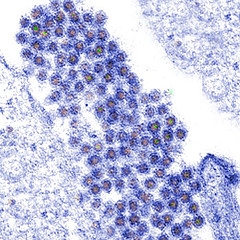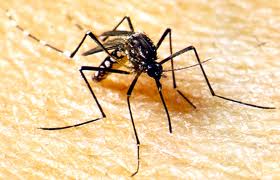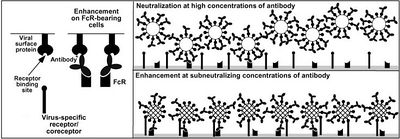Effects of Pathogen-Vector Interactions on the Transmission of Dengue Virus: Difference between revisions
(Created page with 'new page') |
No edit summary |
||
| Line 1: | Line 1: | ||
new | ===Effects of Pathogen-Vector Interactions on the Transmission of Dengue Virus=== | ||
{{Curated}} | |||
{{Viral Biorealm Family}} | |||
<br> | |||
==Dengue Virus== | |||
<br> | |||
[[File:Micrograph of dengue virus.jpg|240px|thumb|left|Figure 1. Electron micrograph of dengue virus (DENV).[1]]] | |||
<br><br> | |||
<br> Group IV: ss(+)RNA virus | |||
<br> Family: <i>Flaviviridae</i> | |||
<br> Genus: <i>Flavivirus</i> | |||
<br><br> | |||
[[File:Aedes aegypti.jpg|400px|thumb|right|Figure 2. Main vector of dengue virus, <I>Aedes aegypti</I> or the Asian tiger mosquito.[2]]] | |||
<br> | |||
Dengue virus is the causative agent of both classical dengue fever and the more severe dengue hemorrhage fever (DHF) and dengue shock syndrome (DSS)[3]. It is most commonly transmitted by the mosquito vector <I>Aedes aegypti</I>but can replicate within and be transmitted by other members of the genus <I>Aedes</I> including <I>Aedes albopictus</I> (Figure 2)[4]. There are four different serotypes of dengue virus (DENV 1-4). Infection with one serotype affords life-long immunity to that serotype but only partial (heterologous) immunity to other serotypes for a short period of time post-infection. After this initial, partial immunity the risk of developing dengue hemorrhage fever and dengue shock syndrome upon reinfection by another dengue serotype increases. | |||
<br><br> | |||
This increased risk for severe dengue is a result of antibody-dependent enhancement of viral infection. Dengue virions bind to host heterotypic non-neutralizing antibodies from previous dengue infection. After recent dengue infection there are enough antibodies to neutralize the virus but over time the number of neutralizing antibodies drop to a level where antibodies bind some but not all viral surface entry proteins. This anti-body-virion complex binds to FcγR receptors found on the surface of a variety of immune cells as seen in figure ??. | |||
<br> | |||
[[File:AD enhancement figure.jpg|400px|thumb|center|Figure ?. Antibody-dependent enhancement of DENV infection. [2]]] | |||
<br> | |||
Normally when a pathogen-antibody complex binds to an FcγR receptor it initiates a cytoxic or phagocytoic response depending on the the immune cell type. Somehow the virus avoids this response and is brought close enough to its host cell receptor which it can bind and infect the cell. The FcγR receptors increase infectivity of the virus in immune cells by increasing overall viral load within the patient which in turn increases the risk of severe complications from dengue infection such as DHF and DSS much more likely. | |||
<br><br> | |||
Within serotypes dengue viruses are organized by genotypes, then subtypes, then clades, variants, groups and finally strains [3]. The large number of dengue strains in the world combined with only partial crossover immunity to other strains makes concurrent (multiple strain) infections or reoccurring dengue infections possible (just like repeated bouts of the flu), especially in areas that have a high prevalence of dengue virus. | |||
<br><br> | |||
Dengue viruses are now endemic to tropical areas of the world putting about a third of the world’s population at risk of infection. There are estimated to be over one hundred million new infections per year and rising [4,5]. The rising rates of infection are the result of reduced vector control in areas that need it most and increased vector range. Global warming has made winters much milder at higher latitudes allowing adult and larvae mosquitoes to survive longer into the fall and return earlier in the spring. Dengue virus is becoming a threat to industrialized nations once thought to be too far away from the tropics for Dengue fever to be a threat. In the U.S. the number of indigenous dengue cases is rising. In Brownsville Texas, 25% of the residents who had never travelled outside the united states had antibodies indication prior exposure to the virus [discover article] [6]. | |||
<br><br> | |||
The severity of dengue infection also continues to increase. The ratio of dengue hemorrhage fever and dengue shock syndrome cases to classical dengue fever have increased dramatically over the past sixty years. It has become the leading cause of hospitalization and death in children in several endemic countries [6]. | |||
<br> | |||
Revision as of 06:00, 7 December 2010
Effects of Pathogen-Vector Interactions on the Transmission of Dengue Virus
A Viral Biorealm page on the family Effects of Pathogen-Vector Interactions on the Transmission of Dengue Virus
Dengue Virus
Group IV: ss(+)RNA virus
Family: Flaviviridae
Genus: Flavivirus
Dengue virus is the causative agent of both classical dengue fever and the more severe dengue hemorrhage fever (DHF) and dengue shock syndrome (DSS)[3]. It is most commonly transmitted by the mosquito vector Aedes aegyptibut can replicate within and be transmitted by other members of the genus Aedes including Aedes albopictus (Figure 2)[4]. There are four different serotypes of dengue virus (DENV 1-4). Infection with one serotype affords life-long immunity to that serotype but only partial (heterologous) immunity to other serotypes for a short period of time post-infection. After this initial, partial immunity the risk of developing dengue hemorrhage fever and dengue shock syndrome upon reinfection by another dengue serotype increases.
This increased risk for severe dengue is a result of antibody-dependent enhancement of viral infection. Dengue virions bind to host heterotypic non-neutralizing antibodies from previous dengue infection. After recent dengue infection there are enough antibodies to neutralize the virus but over time the number of neutralizing antibodies drop to a level where antibodies bind some but not all viral surface entry proteins. This anti-body-virion complex binds to FcγR receptors found on the surface of a variety of immune cells as seen in figure ??.
Normally when a pathogen-antibody complex binds to an FcγR receptor it initiates a cytoxic or phagocytoic response depending on the the immune cell type. Somehow the virus avoids this response and is brought close enough to its host cell receptor which it can bind and infect the cell. The FcγR receptors increase infectivity of the virus in immune cells by increasing overall viral load within the patient which in turn increases the risk of severe complications from dengue infection such as DHF and DSS much more likely.
Within serotypes dengue viruses are organized by genotypes, then subtypes, then clades, variants, groups and finally strains [3]. The large number of dengue strains in the world combined with only partial crossover immunity to other strains makes concurrent (multiple strain) infections or reoccurring dengue infections possible (just like repeated bouts of the flu), especially in areas that have a high prevalence of dengue virus.
Dengue viruses are now endemic to tropical areas of the world putting about a third of the world’s population at risk of infection. There are estimated to be over one hundred million new infections per year and rising [4,5]. The rising rates of infection are the result of reduced vector control in areas that need it most and increased vector range. Global warming has made winters much milder at higher latitudes allowing adult and larvae mosquitoes to survive longer into the fall and return earlier in the spring. Dengue virus is becoming a threat to industrialized nations once thought to be too far away from the tropics for Dengue fever to be a threat. In the U.S. the number of indigenous dengue cases is rising. In Brownsville Texas, 25% of the residents who had never travelled outside the united states had antibodies indication prior exposure to the virus [discover article] [6].
The severity of dengue infection also continues to increase. The ratio of dengue hemorrhage fever and dengue shock syndrome cases to classical dengue fever have increased dramatically over the past sixty years. It has become the leading cause of hospitalization and death in children in several endemic countries [6].



